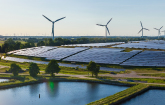DUBLIN, March 29, 2021 /PRNewswire/ -- The "Smart Energy Market by Product, End-User Industry: Global Opportunity Analysis and Industry Forecast, 2020-2027" report has been added to ResearchAndMarkets.com's offering.
The global smart energy market was valued at $124.0 billion in 2019, and is projected to reach $253.1 billion by 2027, growing at a CAGR of 9.6% from 2020 to 2027.
Smart energy is a sustainable energy solution that is integration of different energy infrastructure. It has the flexibility to serve large number of end users without fail. Smart energy utilizes distributed generation, which gives the capability to reduce electricity cost, improve reliability, and decrease emission rates. Furthermore, the real time pricing of smart energy system allow consumers to vary their demand and usage in response to such prices and manage their energy costs.
Growing emphasis on the application of sustainable energy resources such as solar and wind, coupled with installation of mandatory smart meters will drive the market growth. For instance, Government of India is planning to replace 250 million conventional meters into smart meters by 2022. In addition, shifting trend toward efficient energy technologies and implementation of IOT (internet of things) will further drive the demand for smart grids. Advanced metering infrastructure technology is expected to gain traction during the forecast timeframe, owing to increase in expenditure on infrastructure development.
Advanced metering technology has large importance in improving system efficiency and reliability. In addition, smart metering gives the customer organized data regarding their electricity consumption. This information reaches the consumer at regular intervals as programmed and is also accurate and error free, unlike the data obtained through manual meter reading. However, smart energy requires high initial investment, which is a big problem during the initial phase. Moreover, the system requires integration of large number of systems, including work management systems, mobile workforce management, and distribution automation systems.
Nonetheless, favorable government policies including net metering tariffs and time-of-use pricing, interconnection and technology standards, subsidies, targets and goals, customer privacy protection laws will create further opportunities in the market.
The global smart energy market is segmented on the basis of product, end-user industry, and region. On the basis of product, it is divided into smart grid, digital oilfield, and smart solar, and home energy management system. Based on end-user industry, it is categorized into residential, industrial, and commercial. Region-wise, it is analyzed across North America, Europe, Asia-Pacific, and LAMEA.
Major players have adopted product launch, collaboration, and acquisition to sustain the intense market competition. Some of the key players profiled in the report include General Electric, Itron, Honeywell International, Siemens, ABB Group, and Larsen & Toubro.
COVID-19 scenario analysis
- The smart energy market has been severely impacted by the outbreak of COVID-19 across the globe. The market witnessed large fall in demand from the manufacturing and production centers, owing to large number of shutdown in industrial sector.
- As the demand from end user gradually decreased, the wholesale electricity price also decreased.
- But, shifting trend toward work from home norms and growing energy demand from residential sectors will foster the market growth.
- Nonetheless, social distancing norms and lockdown measures across the globe led to supply chain disruption in the smart energy market.
- Social distancing norms affected the availability of equipment and spare parts, thus, negatively impacting the maintenance and infrastructure development activities.
- In the post COVID period, industry players will focus to re-asses their supply chain and consider whether sourcing from domestic players closer to operational site may improve the supply chain.
Key Benefits for Stakeholders
- The global smart energy market analysis covers in-depth information of major industry participants.
- Porter's five forces analysis helps analyze the potential of buyers & suppliers and the competitive scenario of the industry for strategy building.
- Major countries have been mapped according to their individual revenue contribution to the regional market.
- The report provides in-depth analysis of the global smart energy market forecast for the period 2020-2027.
- The report outlines the current global smart energy market trends and future estimations of the market from 2019 to 2027 to understand the prevailing opportunities and potential investment pockets.
- The key drivers, restraints & market opportunity and their detailed impact analysis are explained in the study.
Key Topics Covered:
CHAPTER 1: INTRODUCTION
1.1. Report description
1.2. Key benefits for Stakeholders
1.3. Key Market Segments
1.4. Research methodology
1.4.1. Primary research
1.4.2. Secondary research
1.4.3. Analyst tools and models
CHAPTER 2: EXECUTIVE SUMMARY
2.1. Key findings of the study
2.2. CXO perspective
CHAPTER 3: MARKET LANDSCAPE
3.1. Market definition and scope
3.2. Key findings
3.2.1. Top investment pockets
3.2.2. Top winning strategies
3.3. Porter's five forces analysis
3.4. Market share analysis & Top player positioning, 2019
3.4.1. Top player positioning, 2019
3.5. Market dynamics
3.5.1. Drivers
3.5.1.1. Robust investment in smart grid technologies
3.5.1.2. Shift towards efficient energy technologies
3.5.1.3. Advanced metering infrastructure
3.5.2. Restraint
3.5.2.1. High capital investment and integration of complex technologies
3.5.3. Opportunity
3.5.3.1. Favorable government policies
3.6. Impact of Covid-19 Outburst on Smart Energy Market
CHAPTER 4: SMART ENERGY MARKET, BY PRODUCT
4.1. Overview
4.1.1. Market size and forecast
4.2. Smart Grid
4.2.1. Key market trends, growth factors, and opportunities
4.2.2. Market size and forecast, by region
4.3. Digital oilfield
4.3.1. Key market trends, growth factors, and opportunities
4.3.2. Market size and forecast, by region
4.4. Smart Solar
4.4.1. Key market trends, growth factors, and opportunities
4.4.2. Market size and forecast, by region
4.5. Home energy management system
4.5.1. Key market trends, growth factors, and opportunities
4.5.2. Market size and forecast, by region
CHAPTER 5: SMART ENERGY MARKET, BY END-USER INDUSTRY
5.1. Overview
5.1.1. Market size and forecast
5.2. Residential
5.2.1. Key market trends, growth factors, and opportunities
5.2.2. Market size and forecast, by region
5.3. Industrial
5.3.1. Key market trends, growth factors, and opportunities
5.3.2. Market size and forecast, by region
5.4. Commercial
5.4.1. Key market trends, growth factors, and opportunities
5.4.2. Market size and forecast, by region
CHAPTER 6: SMART ENERGY MARKET, BY REGION
6.1. Overview
6.2. North America
6.3. Europe
6.4. Asia-Pacific
6.5. LAMEA
CHAPTER 7: COMPETITIVE LANDSCAPE
7.1. Introduction
7.2. Product mapping of top 10 players
7.3. Competitive Heatmap
7.4. Key development
7.4.1. Agreement
7.4.2. Product Launch
CHAPTER 8: COMPANY PROFILES
8.1. General Electric Company
8.1.1. Company overview
8.1.2. Company snapshot
8.1.3. Operating business segments
8.1.4. Product Portfolio
8.1.5. Business performance
8.1.6. Key strategic moves and developments
8.2. SIEMENS AG
8.2.1. Company overview
8.2.2. Company snapshot
8.2.3. Operating business segments
8.2.4. Product portfolio
8.2.5. Business performance
8.2.6. Key strategic moves and developments
8.3. ABB Ltd.
8.3.1. Company overview
8.3.2. Company Snapshot
8.3.3. Operating business segments
8.3.4. Product portfolio
8.3.5. Business performance
8.3.6. Key strategic moves and developments
8.4. HONEYWELL INTERNATIONAL INC.
8.4.1. Company overview
8.4.2. Company snapshot
8.4.3. Operating business segments
8.4.4. Product portfolio
8.4.5. Business performance
8.4.6. Key strategic moves and developments
8.5. ITRON
8.5.1. Company overview
8.5.2. Company snapshot
8.5.3. Operating business segments
8.5.4. Product Portfolio
8.7. Sensus
8.7.1. Company overview
8.7.2. Company snapshot
8.7.3. Operating business segments
8.7.4. Product Portfolio
8.8. S&T Smart Energy
8.8.1. Company overview
8.8.2. Company snapshot
8.8.3. Operating business segments
8.8.4. Product Portfolio
8.9. Landis + Gyr
8.9.1. Company overview
8.9.2. Company snapshot
8.9.3. Operating business segments
8.9.4. Product Portfolio
8.9.5. Business performance
8.10. Schneider Electric
8.10.1. Company overview
8.10.2. Company snapshot
8.10.3. Operating business segments
8.10.4. Product portfolio
8.10.5. Business performance
For more information about this report visit https://www.researchandmarkets.com/r/s3v41x
Media Contact:
Research and Markets
Laura Wood, Senior Manager
[email protected]
For E.S.T Office Hours Call +1-917-300-0470
For U.S./CAN Toll Free Call +1-800-526-8630
For GMT Office Hours Call +353-1-416-8900
U.S. Fax: 646-607-1904
Fax (outside U.S.): +353-1-481-1716
SOURCE Research and Markets

Related Links
WANT YOUR COMPANY'S NEWS FEATURED ON PRNEWSWIRE.COM?
Newsrooms &
Influencers
Digital Media
Outlets
Journalists
Opted In





Share this article